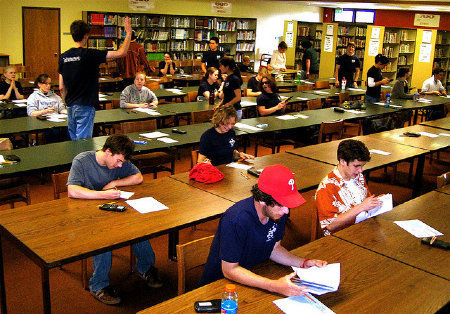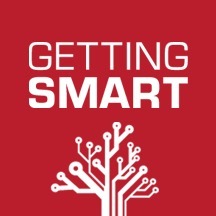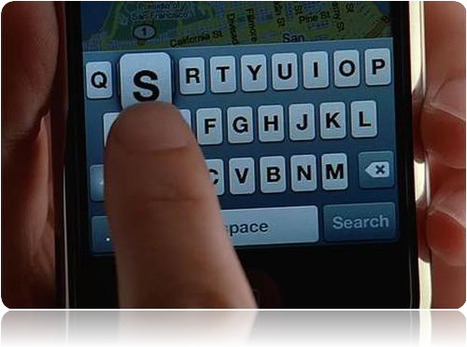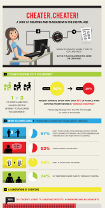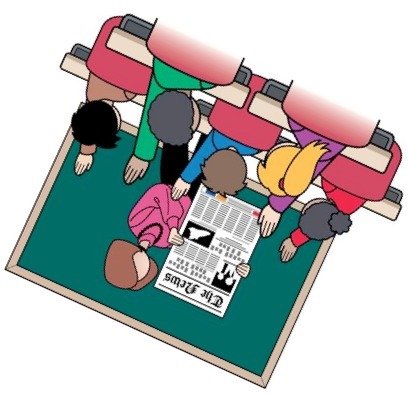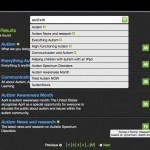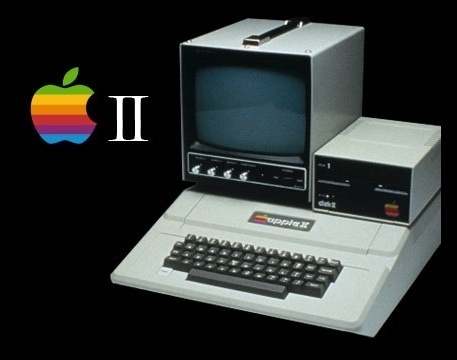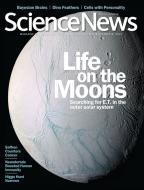 Your new post is loading...
 Your new post is loading...

|
Scooped by
Mel Riddile
|
"I've always wanted a document camera in my classroom, so yesterday I made my own - using my iPad. Here's a quick rundown of how to do this: Purchase a VGA Adapter Cable. You can pick one up online for around 20 bucks.
Create your iPad stand. For mine, I borrowed a ring stand from the science department and clamped it to a clipboard. It was sturdy and could safely accommodate the weight of my iPad.
Use a VGA cable to connect the adapter to the projector. You now have a fully functioning document camera!"

|
Scooped by
Mel Riddile
|
"According to recent research, 71% of today's students do not believe copying from the Web constitutes “serious cheating.” Shocking? Maybe. But there's no denying that the Internet makes it that much easier to copy and paste. Perhaps that's why some students are falling victim to cheating and plagiarism. To help steer you in the right direction academically, we've put together a list of 5 tips that will help you beat the cheat."--Schools.com 1. Use citations 2. Take notes 3. Be wary of online sources 4. Be comfortable with your voice 5. Trust your writing skills To read further, click on the headline of this scoop.

|
Scooped by
Mel Riddile
|
"None of us is as smart as all of us.”
—Ken Blanchard
What if you could tap into the collective intelligence of hundreds or even thousands of your fellow educators? Would their collective experience and knowledge be of value to you in your position?
I always thought that Twitter was a tool for groupies who wanted to know where their favorite celebrity or sports star was eating or vacationing. One of my colleagues and I had been discussing Twitter and I decided to give it a try. All I needed was the right opportunity.
I was scheduled to attend a Pew Research conference on generational research, and I thought that it might be a good time to try Twitter on my iPhone. I mentioned it to one of my colleagues who thought it would be a good idea because there would probably be few people at the meeting using Twitter. Boy, was he wrong.
When I arrived, I immediately saw a hashtag, #millenials, posted on the screen. As the meeting began, I started using Twitter to take notes, albeit 140 characters at a time. All at once I noticed on the feed that someone from NPR and the Washington Post was posting tweets. Within a short period of time I realized that more than 20 individuals from a wide variety of organizations were posting to Twitter. It felt as though I was a part of a 20-person team of note takers. Any preconceived notions that I had about Twitter were immediately dispelled. I was now hooked on Twitter as a way to gather and collect knowledge and information. Constructing Your PLN
I once worked for a principal who told the staff "I am not a reader." Translation: I am not a learner. Needless to say, that statement went over like a proverbial lead balloon.
Being an instructional leader means that we are leaders of learning or learning leaders, and, in the real world, the "lead learner is the learning leader." In the past, school leaders were expected to know all the answers, but in today's fast-paced knowledge economy, leaders cannot know the answers to questions that haven't been asked yet. Instead, school leaders are expected to be willing to learn and to ask better questions.
To read further, click on the headline of this scoop.

|
Scooped by
Mel Riddile
|
I have recently written about using Twitter as a part of your Personal Learning Network (PLN) http://bit.ly/pveBOU Justin Tarte offers some of his own thoughts on Twitter to identify valuable classroom resources: 1. Videos ( Xtranormal) - "I came across a Tweet about Xtranormal, which is a text-video program. "If you can type, you can make movies," is the slogan, and I immediately felt the need to explore further. Two hours later I created this: http://www.xtranormal.com/watch/7436973/ I now plan on having my German 3 students write their own movie scripts, and ultimately make their very own movies to share with others. I showed my students my example today in class, and they loved it! Without Twitter, I would probably still not know this program exists... 2. Writing (Wallwisher) - A couple week ago, Thomas Whitby encouraged educators to blog about educational reform. Once each educator completed his/her blog post, we then posted a short comment and the link to Wallwisher. This was the first time I had ever heard of or used Wallwisher. Today in my German 2 classes we created 3 different "walls," one for each class. I then had each student think about what he/she did on the weekend. Once each student had time to think, I asked each student to come to the computer projector, and type what he/she did this weekend. The remaining students in the class were given the task of helping the student at the computer with grammar and proper spelling. This worked well because the students were able to work as a group to help each other. Without Twitter, I still might not know about Wallwisher. Here is the "wall" for my 2nd hour German 2 class: http://www.wallwisher.com/wall/xX6iEUKvO8

|
Scooped by
Mel Riddile
|
Color-coded student IDs and separate lunch lines ignited controversy in Orange County. Why? When you place reasonable people in unreasonable circumstances, they sometimes behave unreasonably. In this case, California schools are being closed, teachers are being fired, and principals are being transferred or terminated on the basis of state test scores. The real problem is that California refuses to hold students accountable for test results. These tests don't matter for the students. So, some students simply "Christmas Tree" http://bit.ly/a7Ujmb tests, and thus, the careers of professional educators and the reputation of the school and its surrounding community rests on the good will of their students. Holding students accountable by making the tests barriers to graduation works. I know. I worked in a state (VA) prior to the graduation requirement and after it took effect. Our local incentives coupled with caring, dedicated teachers worked, but the "barrier" requirement strongly supported our efforts. Mel Riddile, The Principal Difference ---- The Story by Liz Dwyer Background: "With higher stakes associated with standardized tests than ever before, rewards like a pizza party or an extra school dance are fairly common for students who perform well. But two high schools in Orange County, California have ignited controversy for a rewards program that treated low performers like second-class citizens. The two schools' questionable motivational tactics involved issuing color-coded student identification cards based on performance on state tests. High-performing students received black cards, the ones in the middle got gold ones, and the lowest-scoring group got white IDs. The schools then awarded discounts and perks around campus to the students with the black and gold cards. According to The Orange County Register, black cardholders got into home athletic events for free and received "discounts to school dances and at local businesses." Students with gold card were offered more limited discounts. As for white cardholders, they were forced to pay full price for everything and had to stand in a separate, slower lunch line in the cafeteria." The Commentary Teachers find themselves in a tough position, because they're held accountable for student performance on state tests, ranked as either good or bad based on their students' scores. But shaming kids for not scoring well on one high-stakes test isn't the best way to promote learning. Incentive programs like this may convince a handful of students to improve their performance, but they do much more to hurt students who aren't already high scorers. It must be pretty terrible to go to school knowing you're visually labeled as one of the dumb kids because of the color of your ID, even if you tried your best on the test and otherwise get good grades. It's worthwhile to reward kids for improving their performance, but there has to be a more positive, less humiliating way to do it. For more on this, click on the headline above.

|
Scooped by
Mel Riddile
|
Responsible school improvement requires a change in the culture of the school--a change in the attitudes, beliefs, values, and professional pratices. Changing the culture cannot be done by fiat or in one or two meetings a year. Changing the culture requires that school leaders simplify, clarify and amplify the school's vision. The effectiveness of our efforts to "amplify" the vision is based on the frequency with which we communicate that clear and simple message. In our school, our vision was R-A-G-S. Reading plus Attendance means better Grades and a Safer school. We knew that if we could improve student attendance and teach our students literacy (reading for comprehension, writing, thinking, speaking, and listening), student achievement would improve and discipline problems would decrease. Mel Riddile ---- How Social Media an Enhance Schools as PLCs by resourcelinkbce September 21, 2011 "For over ten years, I wrote a weekly newsletter on topics related to our school's vision, mission, and goals. Writing 1,500 words a week is a daunting task. Today, I can use social media to, not only increase the quality and frequency of communications, but also reduce the time it takes to generate the messages. "The field of social media is a burgeoning area of communication, and one that educators cannot ignore. Facebook, Twitter, LinkedIn, Diigo, GooglePlus – these platforms for communication are not going to go away; and while there is a great deal of negative media surrounding their use, they can be harnessed to create myriad possibilities for schools as learning communities. Current research only proves the dominance of Social Media as a modern communication medium: http://blog.nielsen.com/nielsenwire/social/
1. Social media providing time to collaborate 2. Social media providing leadership support 3. Social media providing information 4. Social media providing ready access to colleagues" More.....

|
Scooped by
Mel Riddile
|
Cellphones in hand, Hinsdale Central students click away at text messages in the high school cafeteria. In the hallways between classes, they phone home to check in with parents. This year Hinsdale High school opted to let students use phones between classes, during lunch periods and — when teachers give permission — in the classroom. "It's pretty much the same amount of phone use around here. Last year we would just hide it from teachers." Assistant Principal's Take "Assistant Principal Bill Walsh said administrators at the school began noticing most violations of cellphone use were coming from study hall, the cafeteria and school hallways — not during instructional time. For this reason, they decided to take another look and re-evaluate the policy, which in the past prohibited cellphones and similar devices during school hours. "This year we've chosen to be less restrictive in noninstructional areas," Walsh said. "It's about defining what's appropriate use for an educational environment during a time of expanding technology." The policy covers computers, laptops and iPods, as well as cellphones. "We're encouraging opportunities for students to engage in technology to further the learning process," Walsh said. "There are ways for the students to create educational opportunities using electronics during the school day." "But Walsh said he hasn't seen a drastic change in the hallways of Hinsdale Central. He's noticed just a few extra texters and some students using headphones between classes." "Bandwidth "is something we're looking into going down this avenue," Walsh said. "Questions like, 'When we max connectivity, what are we going to do?'" Cellphone Policies Vary "There are variations to cellphone policies throughout the Chicago area. After nearly 13 years of banning cellphones, Maine Township High School District 207, which serves Des Plaines, Park Ridge and parts of several nearby towns, loosened its rules in August after school officials called their "off and away" policy outdated and pointed out most students don't follow it anyway. Students can now use the phones in limited case such as emergencies, individualized educational programs and for instructional purposes during class. But Glenbard District 87 high schools in Glen Ellyn, Lombard and Carol Stream still ban phone use during the school day. "In order to maintain a positive educational environment, we limit the use of cellphones to before and after school hours only. During the school day, students must store their cellphones in their lockers," spokeswoman Peg Mannion said. Cellphone applications are used in some classes, and personal phone use is allowed in designated areas in District 211 high schools, which serve Hoffman Estates, Inverness, Palatine, Schaumburg and parts of seven other towns." Teachers' Take on Cellphones Teachers give the new policy mixed reviews. That might be explained by one student's observation that some teachers still rule with an iron fist when it comes to cellphones. "Some teachers will still take away your cellphone if they see it out in class," said Nicole Stankus, a sophomore at Hinsdale Central. "I don't see them as a distraction. They aren't being used 24/7. I use mine during the school day mostly to check grades." "The new policy allows the students more freedom. We want them to feel comfortable here," special education teacher Brent Kujawa said. "As long as it's not interfering with class time, I don't see it as a problem." Family and consumer science teacher Marge McMahon sees drawbacks. The more students use cellphones to communicate, the less they're working on necessary life skills, she said. "They don't know how to talk to each other — make eye contact, listen for inflections, think of a reply quickly on their feet," McMahon said. "That's a decline in communication skills they'll all need to survive in the professional world." McMahon said she hasn't felt cellphones infringing on class time, but she has noticed the school's bandwidth has slowed tremendously.

|
Scooped by
Mel Riddile
|
SearchTeam.com, the world's first real-time collaborative search engine, by Zakta, has been launched. You can search the Web together with friends, curate what you need, while collaborating with them in real-time, or asynchronously.

|
Scooped by
Mel Riddile
|
A growing number of teachers digitally record lectures, then upload them to iTunes and assign them as homework. Advantages "Teachers say flipped, or upside-down, classes offer: 1. greater control of material. She says it's all about helping students understand difficult material. Flipping the classroom, she says, has made her students more independent, less-stressed learners, because for many students, the hardest part is applying the lesson to problem sets. 2. more face time with students. Frank Noschese, a physics teacher at John Jay High School in Cross River, N.Y., says anything that gives teachers more face time with students is "a good thing." But he says lecturing, even at a leisurely pace, is still bad pedagogy. "It's just kind of 'Lecture 2.0.'"

|
Scooped by
Mel Riddile
|
1. Become an organ donor. 2.Watch this speech:...

|
Scooped by
Mel Riddile
|
“The history of online education” that shows the ways in which distance learning has developed since the early 1700s to now. It looks at the ways that students and teachers are using education technology to learn from anywhere. The infographic projects that in the future online learning enrollments among post-secondary education will increase from 30 percent this year to 37 perent in 2015."

|
Scooped by
Mel Riddile
|
We all know that improving our education is good for us, but we also know that doing so is often expensive and a bit time consuming.

|
Scooped by
Mel Riddile
|
By 2015, every Loudoun public school teacher and fourth- through
12th-grade student will be assigned a personal digital device of
some sort, if the school division's proposed Educational Technology
Plan is approved as is.
|

|
Scooped by
Mel Riddile
|
"As technology evolves, society often follows, which is why some Metro Detroit schools are softening their former restrictions on cellphone use in the classroom. Once considered a distraction best banished to lockers during the day, cellphones increasingly are becoming an educational tool. While some high schools still ban phones in class, some districts — such as Plymouth-Canton and Chippewa Valley — are allowing teachers to explore the benefits of instant class connectivity and feedback." Read on by clicking on the headline above.

|
Scooped by
Mel Riddile
|
Schools.com provides an infographic titled "Cheater, Cheater: A look at cheating and plagiarism in the digital age." "The consequences of cheating used to instill fear into many a student. But it seems these days, kids just don’t care about academic honesty anymore. Many students can’t even distinguish between what constitutes plagiarism and what doesn’t. According to recent research, 71% do NOT believe copying from the Web is “serious cheating.” Have sites like Wikipedia blurred the lines on cheating all together? What will become of this generation of cheaters? Find out in the below infographic."

|
Scooped by
Mel Riddile
|
New teacher Patricia Paiva plans a lesson that incorporates technology with coach and social media expert Sheryl Nussbaum-Beach. Watch how the lesson goes and see the students' reactions.

|
Scooped by
Mel Riddile
|
The "Essential iPad Guide for Principals" and school leaders via Justin Baeder is available for freee download.

|
Scooped by
Mel Riddile
|
Coaching Point: When it comes to change, the school principal is the proverbial "cork in the bottle." The following article demonstrates once again that nothing happens without the full and active support of the school leader. Mel Riddile --- Principal, Eric Sheninger of New Milford High School shares 'how his school adopted social media." "We have seen many shifts in terms of instruction, communication, and learning at NMHS resulting in a transformative culture that is more in line to meet the needs of our students. Steps: 1. Change the leader's attitude re social media 2. Educate the staff on the value of social media 3. Include students 4. Reflecting, sharing, networking Small Changes Make a Big Difference "These small changes, combined with many others, are beginning to have a huge impact on the teaching, learning, and community culture of my school. Even though I have highlighted examples specific to technology, there have also been changes focused on curriculum and programming. Politicians and self-proclaimed reformers routinely throw around the word change and think that a one-size-fits-all approach is what's needed to increase student achievement and innovation. Each school is an autonomous body with distinct dynamics that make it unique. It's the small changes over time that will eventually leave a lasting impact. Schools and educators need to be empowered to make these changes as they see fit. In my eyes, this is the type of reform that is needed." more....

|
Scooped by
Mel Riddile
|
1. Many of our students don't have access to technology at home. The flipped classroom method does not have strong provisions in place for these children.
2. Flipped homework is still homework...
There is a growing number of parents and educators who don't believe we should rob children of the time after school with mandatory homework. We believe time at home should be for pursuing passions, connecting with friends and family, playing and engaging in physical activity. In some families it might be the time needed to take care of a sibling, work a job, or take care of their own child. Let us leave children to the activities they and their family choose or find necessary and instead as John Taylor Gatto suggests (in lesson 7), that we should "give children more independent time during the school day" at which time they may also choose to watch flipped classroom lessons.
3. More time for bad pedagogy...
Flipping instruction might end up just meaning we can provide time to do more of the same type of memorization and regurgitation teaching that just doesn't work. When I shared the idea of the Flipped Classroom with an administrator, she said to me with excitement, "This is great! We'll have more class time to prepare kids for the tests!"
4. Grouping by date of manufacture...
If we really want transformation in education, one thing we must do is stop grouping students by date of manufacture, which the flipped classroom is ideally suited for, but have schools put the structures in place? Are they ready to let students move at a pace that meets their developmental readiness and come to the realization that not everyone at the same age needs to be at the same place at the same time? True flipping should include a careful redesign of learning environment, but this is often overlooked.
5. Lecturing doesn't = Learning... The flipped classroom is built on a traditional model of teaching and learning. I lecture - you intake. While this method of teaching works for some learners, many others thrive with a model that takes a more constructivist approach.

|
Scooped by
Mel Riddile
|
RT @joycevalenza: New post: Curation is the new search tool http://t.co/6qI0qk9G #tlchat #edchat #library...

|
Scooped by
Mel Riddile
|
How does Apple create the buzz for a phone and "How can we create that hype in our classrooms?" Lyn writes: "How do our teachers help students develop a legitimate desire to learn more, do more, say more, be more? How do we encourage our teachers to design learning opportunities that leave students wanting more at the end of the school day? When parents ask, “What did you do in school today?”, don’t we want students belting out accolades about the day’s projects, debates, research, and collaborative interactions? Meet students where they are? "I think knowing how to design learning opportunities that embrace students’ passions and interests and allowing them to interact with peers within their own schools and with others around the world is key." "We must allow them to use technology in order to facilitate learning experiences, and our teachers must partner with students to help support them, to challenge their assumptions, and to show them that they’re capable of greatness." more...

|
Scooped by
Mel Riddile
|
GOLDEN, Colo. — A man charged with attempted first-degree murder in the shooting and wounding of two eighth-graders at a Colorado middle school was found not guilty by reason of insanity Wednesday.

|
Scooped by
Mel Riddile
|
My 1st Apple: Drove 50 miles to buy an Apple II+ in a tent. Thanks, Steve!
When I took my first Apple II to work, my secretary cried. She thought that the PC would replace her. That was 1978!

|
Scooped by
Mel Riddile
|
Third grade a turning point in how kids solve math problems...

|
Scooped by
Mel Riddile
|
Funding professional development and teacher retention may not be as thrilling as giving every student an iPad, but it’s more likely to help kids learn, argues Jack Schneider. "In a time of budget shortfalls, money is raining down on educational technology projects. Why? 1. For one thing, it can be easy to credit technology for what makes a class “work.” Head to a thriving school where every student has a tablet computer, and you might be tempted to think that you’ve stumbled on a solution: Tablet PCs help kids thrive! You are also likely, however, to be on campus at a well-resourced school with lots of other things going for it. Working to pinpoint a particular practice that makes a good school work, in other words, is to deny the deep complexity of the educational environment. 2. The other reason that the reform elite loves technology is that it can be taken to scale. Great teachers, after all, are also easy to credit for a school that works. But how do we get one in every classroom? The iPad, on the other hand, requires only a checkbook.
|



 Your new post is loading...
Your new post is loading...






